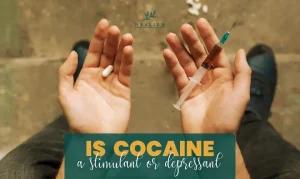
The decision to use cocaine often results from either anxiety relief or as a chosen lifestyle.
To understand its effects, we can categorize drugs into two types: stimulants that stimulate activity, and depressants that cause relaxation.
Now, the question arises: is cocaine a stimulant or depressant?
Let’s explore the facts to understand how cocaine interacts with the body and mind, and its place in the spectrum of psychoactive substances.
What is Cocaine?
Cocaine comes from a plant that grows in South America, it’s an illegal Schedule II drug, and can cause addiction.
Cocaine is also found in a crystal form called “crack cocaine.” Through a process called “freebasing,” it’s heated to create smoke breathed into the lungs.
Likewise, certain street sellers mix Cocaine with other substances like amphetamines or heroin. They create a combination known as a “speedball,” which can be riskier than using Cocaine alone.
Crack Cocaine and Powdered Cocaine
Cocaine is available in various forms — it is commonly sold as a white powder, often called Coke, and people usually snort it.
Another form is known as crack Cocaine or simply ‘crack,’ which comes in rock-like structures. Crack emerged in the 1980s as a more affordable option to Cocaine.
Furthermore, crack is made from powdered Cocaine mixed with water and baking soda — this is heated and cooled down into crystal rocks.
What Is the Difference Between Stimulant and Depressant Drugs?
Stimulant and depressant drugs are two distinct categories with opposite effects on the central nervous system:
Stimulant Drugs
Stimulants are substances that boost energy levels and enhance alertness.
Referred to as uppers, these drugs induce a sense of heightened wakefulness and activity, though they may occasionally result in feelings of anxiety and aggression.
Caffeine, methamphetamine, nicotine, and prescription stimulants are among the commonly encountered stimulants.
Thus, the stimulating effects of these drugs can affect an individuals’ cognitive performance and focus.
Depressant Drugs
Depressants, commonly referred to as downers, exhibit effects opposite to stimulants.
These substances diminish brain activity and decelerate the central nervous system, reducing mental and physical activity.
They cause a state of calmness, relaxation, and sleepiness.
Examples of common depressants encompass alcohol, benzodiazepines, barbiturates, cannabis, and heroin.
However, depressants are less dangerous than stimulants.
Though, misuse of depressants can lead to consequences such as slowed breathing, impaired judgment, and respiratory arrest.
Stimulant vs Depressant
Stimulants vs depressants – let’s compare them.
| Stimulants | Depressants |
| Increase alertness and energy. | Reduce arousal and slow activity. |
| Enhance dopamine and norepinephrine. | Increase gamma-aminobutyric acid. |
| Improved focus, euphoria. | Calmness, reduced anxiety. |
| ADHD medications, certain asthma treatments. | Anxiety, insomnia, pain management. |
| Caffeine, cocaine, amphetamines. | Alcohol, benzodiazepines, opioids. |
Is Cocaine a Stimulant or Depressant?
An important question is: is cocaine a stimulant or depressant?
Cocaine is a stimulant, not a depressant.
It can cause affects like:
- Alertness.
- Energy.
- Euphoria.
- Too much confidence.
- Paranoia.
- Excitement.
This happens because Cocaine affects neurotransmitters like dopamine in the brain.
Additionally, stimulants generally produce an activating or “up” effect on the central nervous system, leading to heightened arousal and increased physical and mental activity.
Symptoms of Cocaine Addiction
If a person has developed a cocaine addiction, discontinuing its use can result in withdrawal symptoms, including:
- Intense cravings.
- Depression.
- Fatigue.
- Intense mood swings.
- Severe anxiety.
- Lack of focus.
- Insomnia or hypersomnia.
- Tremors and restlessness.
- Severe headaches and stomach pains.
- Suicidal thoughts and actions.
It is vital to seek professional help if you or someone you know is dealing with cocaine addiction.
Side Effects of Cocaine Use
Did Cocaine have any side effects? Certainly, it affects health and behavior negatively.
Extended and consistent use of Cocaine can lead to enduring and potentially life-threatening consequences. These may include:
- Chronic insomnia.
- Chronic nosebleeds.
- Mouth ulcers.
- A perforated septum.
- Respiratory failure.
- Mouth, throat, and lung cancer.
- Severe bowel decay.
- Soft tissue infections.
- Constricted blood vessels.
- Depression.
- Anxiety.
- Weight loss.
- Malnutrition.
- Increased risk of stroke and seizure.
It is important to be aware of these potential risks and seek professional help for people struggling with cocaine addiction to address and mitigate these long-term effects.
Cocaine Effects on the Brain
Cocaine messes with how our brain cells talk to each other.
It’s a super strong stimulant that grabs onto dopamine transporters, stopping them from recycling dopamine.
This increases the dopamine level in the space between brain cells. Dopamine is like a messenger for pleasure.
Moreover, Cocaine makes the brain produce more dopamine.
It causes people to feel happy, like they’re on a high.
That’s why using Cocaine can make someone feel euphoric.
Getting Help for Drug Abuse
If you or someone is stuggling with Cocaine addiction or substance abuse, please reach out for help today.
Healing can provide support by informing you about addiction treatments, resources, and guiding you to wellness.
Feel free to contact us today.
Takeaway
Is cocaine a stimulant or depressant? Cocaine is a stimulant.
It elevates mood, increases alertness and energy, reduces appetite, and induces euphoria.
Stimulants speed up brain activity and boost physical and mental functions by stimulating the sympathetic nervous system.
Cocaine also increases heart rate, blood pressure, and overall metabolic rate.
Cocaine addiction can be extremely harmful to one’s mental and physical health.
If you or anyone you care about is addicted to Cocaine, please find help and support today.
FAQs
What is the difference between a stimulant and a depressant?
The main difference between a stimulant and a depressant is that stimulants activate the central nervous system while depressants have a calming, slowing effect.
Is tequila a stimulant or a depressant?
Tequila is an alcoholic beverage classified as a central nervous system depressant due to its ethanol content, causing a calming effect.
What are the potential consequences of combining stimulants and depressants?
Mixing stimulants and depressants can be dangerous as they interfere with the body’s natural balance.
It can lead to increased risks of overdose, cardiac arrest, respiratory failure, or death because depressants slow the body while stimulants speed it up.
Are depressants less dangerous than stimulants?
Both depressants and stimulants carry risks, and their danger depends on factors like dosage and individual reactions.
Depressants can cause respiratory issues, while stimulants may lead to cardiovascular problems, making neither inherently less dangerous.
Is weed stimulant or depressant?
Weed, or marijuana, is classified as a mild hallucinogenic drug and does not neatly fit into the categories of stimulant or depressant.
Its effects can vary, often inducing relaxation and altered perception.
Is Coke a stimulant?
Yes, Cocaine (often referred to as “Coke”) is a stimulant.
It increases alertness and energy by affecting neurotransmitters like dopamine in the brain.
Are Cocaine and crack are both addictive hallucinogenic drugs?
Cocaine and crack are both addictive stimulant drugs, not hallucinogens.
They increase alertness and energy by affecting neurotransmitters in the brain.
Is heroin a stimulant or depressant?
Heroin is a depressant.
When consumed, heroin binds to opioid receptors in the brain to induce relaxation, pain relief, and euphoria by depressing or slowing down the central nervous system and respiratory function.
